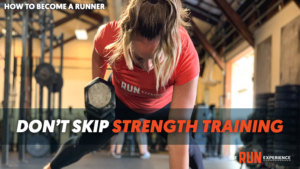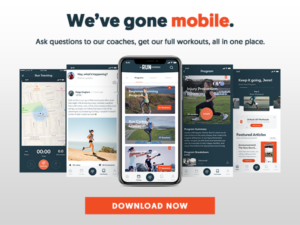How to Become a Runner: A Beginner’s Guide
Learn how to become a runner, no matter where you’re starting from. Here's the step-by-step process to becoming a runner (in no time).

Looking for how to become a runner? You’ve come to the right place.
Running can be a life-changing way to improve your mood and get in shape without a gym membership or any equipment. But with all the information out there, it can be overwhelming to know how to become a runner.
In this article, we here at The Run Experience have laid out some answers to beginner runners’ biggest questions, so you can lace up with confidence.
Whether you’re looking to train for a race, lose weight, or simply improve your fitness, starting a running habit only takes a pair of running shoes and the dedication to get moving. Keep reading to learn exactly how to become a runner, no matter where you’re starting from.
How to Become a Runner (Table of Contents)
Table of Contents
- Find the Right Training Program
- How to Run: A Beginner’s Overview
- Run-Walk-Run Method
- Get the Right Gear
- Where to Run As a New Runner
- Fueling for Your Runs
- Warm Up and Cool Down
- Strength Training for Beginner Runners
- How to Stay Motivated
- How to Start Running to Lose Weight
- How to Become a Runner as a Yogi
- How to Become a Runner if You’re Over 50
- The Most Important Tip for New Runners
Find the Right Training Program
When starting to run, a training program will be your best friend. It will set your training schedule for you, and hold you accountable.
To that end, pick a running plan that’s realistic for your lifestyle and current fitness level. If you want to run a marathon but have yet to run a mile, know that you’ll have to invest some time and mileage before you’re ready to go the distance!
A proper beginner runner’s training plan will tell you how many days a week to run, the duration of the run, and how fast to run.
Check out our 30-day beginner training plan for an easy way to start running now. On The Run Experience mobile app, we have training programs to help with your goals ranging from weight loss, running your first 5k, finishing a half marathon or marathon, or mastering the treadmill. Download our mobile app to get started.
For more on finding the right training program, read our full post to learn more about how to find the right running program as a beginner.
How to Run: A Beginner’s Overview
Nothing feels more frustrating than getting injured right after you start a new exercise regime. Proper running form prevents injury and helps you recover faster and run more efficiently. At first, running may even feel awkward and uncomfortable. That’s okay!
Just pay attention if what you’re feeling is discomfort or pain. Discomfort is normal for new runners, but you should not feel pain. If you are, see your healthcare provider before continuing to run.
Remember, practice makes perfect. The more you run, the more comfortable and natural it will feel. With this in mind, note that proper run form will drastically reduce your chance of injury, and will help make running feel comfortable sooner.
Here is a breakdown of how to run with proper running form, head to toe:
- Head: Place middle finger and thumb on your collarbones. Raise your index finger to touch your chin. Keep this head and gaze position while you run.
- Shoulders: Keep your shoulders back and relaxed.
- Arms: Allow your arms to swing next to your sides without crossing your body’s midline.
- Hips: As you run, keep your hips forward in a neutral position, activating the glutes. Your back should not be arched. Focus on keeping an equal distance between your feet as you run.
- Legs: Find a movement somewhere between a high knee and a butt-kick. Engage your hamstrings and glutes as you lift your feet off the ground.
- Feet: Pick your feet fully up off the ground, avoiding heavy stomping or scuffling.
Want to learn by watching instead? Check out our running form video:
Run-Walk-Run Method
The Run-Walk-Run method, created by Olympian Jeff Galloway, incorporates walk breaks throughout a run’s duration to help your body acclimate to the impact of running. This lessens your chance of running injuries, and gives your muscles and cardiovascular system some recovery time.
It’s a perfect way for beginners to get used to longer runs. Many elite ultramarathoners swear by walk breaks!
To use the Run-Walk-Run method, break up your run with walking breaks, marked by either distance or time. The walking breaks will remain the same length throughout the run.
Don’t only walk when you get tired; stick to the same run-walk intervals for the duration of your run. Remember, the longer the run portion, the more tired you will feel.
As a beginner, try running for 10 to 30 seconds at a conversational pace, keeping your heart rate moderate, and then walking for 1 to 2 minutes for a total duration of your run.
As your fitness level improves, you can increase the time you run and decrease the time you walk.
Use this video to learn more about creating the best Run-Walk-Run strategy as a beginner.
Get the Right Gear
Shoes
Your feet and footwear matter a lot when you run. Rather than grabbing any old pair of sneakers, visit a local running store to have a salesperson help you find the best footwear for your stride-type and body.
Wear athletic clothing to the store, and don’t be shy about asking to jog around in the pair of shoes you try on. Many running stores have treadmills in-store for this very purpose.
Above everything, the right shoes should be comfortable and provide proper arch support.
For more information on what to look for in your first running shoes, listen to Coach Nate’s top three tips when buying your first pair.
Socks
Your socks should fit well, made preferably of moisture-wicking material, and cover your ankle bone, especially if you are prone to blisters near your Achilles. For longer distance running, look for socks that have built-in cushioning and few or no seams that won’t irritate your skin.
Some running socks we love are Darn Tough Vertex Ultra-Light No Show, the Saucony Performance Super Lite No Show, and the Nike Elite Cushioned Ankle socks.
Stopwatch
To start running, any device with a stopwatch function like a cell phone will work just fine for tracking your run time. As you start running more often, consider buying a simple stopwatch to wear on your wrist or investing in a GPS running watch or activity tracker.
Our mobile app has GPS tracking to make logging your running time and distance super easy. Nike Running Club, Strava and Runkeeper can also log your miles using GPS.
And if you’re looking to buy a GPS watch, our pick is the Garmin Forerunner 35, which is one of the best on the market for the price.
Where to Run as a New Runner

Pavement Running
While road-running isn’t the most exciting running location, it is the most reliable, since there are roads and sidewalks everywhere. If you’re running on a road, run the opposite direction of oncoming cars so drivers can see you.
For runs during dawn or dusk, wear bright-colored, reflective clothing and be aware of your surroundings, especially when crossing driveways and intersections.
Trail Running
It’s hard to match the peace and fresh air you’ll get from running in the great outdoors. If you choose to run on a dirt trail, adjust your pace for difficult terrain and incline changes.
Go slow on rocky or muddy paths and, if your route is unfamiliar, make sure you have access to a trail map or phone service so you don’t get lost.
Use Trail Running Project or Trail Link to find well-known trails used by other runners in your area.
Treadmill Running
For beginner runners, a treadmill is a wonderful running option because you have full control of your incline and pace. Start at a walking pace and then gradually increase your speed until you find a comfortable jog.
To mimic the body’s energy output from outdoor running, try running at a 1% incline. You’ll be better prepared for running outside during those windy days!
Ready to hit the treadmill? Try this treadmill workout for beginners:
Track Running
Running on a track combines the benefits of outdoor running with the controlled environment and cushioning of a treadmill. Alternate your running direction every four laps to avoid muscular imbalances.
If other people are running on the track while you’re there, keep proper track etiquette and avoid lane one, as it’s the lane reserved for runners focused on speed work.
Also, always be sure to look behind you before exiting the track to be sure you do not get in anyone’s way as your cross over lanes.
To find a track in your area, use USATF’s track finder or a Google Maps satellite search! Just make sure the track you find is open to the public.
Fueling for Your Runs
Food
For a regular run under 60 minutes, your body’s natural energy stores will provide you enough fuel, so it’s not necessary to eat extra beforehand.
When your run is more intense, if it includes intervals or hill sprints, eat a snack made of simple carbohydrates like a piece of toast with honey or a small bag of pretzels about 60 to 90 minutes before you run.
After your run, replenish your body with healthy sources of protein like low-fat chocolate milk, a serving of nuts and seeds trail mix, or a smoothie with strawberries, blueberries, protein powder, and almond milk.
For more information on running nutrition, here are some of our top tips for how to optimize your diet.
Hydration
As a runner, build the habit of drinking water regularly throughout your day. Since we already lose water from daily living, throwing a sweaty run into the mix makes proper hydration all the more important.
Aim to replenish both water and sodium after your runs, either through a sports drink or another electrolyte product. If you opt for a sports drink, go for one with low or zero sugar.
For electrolyte supplements, try SOS Hydration, Skratch Labs hydration mix, or Nuun tablets.
To learn more hydration tips and about some of the science behind it, check out this video on why proper hydration is so crucial for runners.
Warm Up & Cool Down
Warm Up

Warming up for your run activates your cardiovascular system and key muscles that you’ll use while running. A basic running warm-up should include the following:
- Glute and abs activation. Think exercises like squats, lunges, planks, bridge hip lifts, donkey kicks, and bird-dogs.
- Upper body loosening. A must for desk-workers! Do arm circles, arm swings, and dynamic shoulder stretches.
- Hip loosening. Leg swings, alternating lateral lunges, and skipping are great options.
- Heart-raising. Do some jumping jacks, high-knees, butt-kicks or turn on your favorite song and dance around!
Aim to do each move for 10 to 20 repetitions. If you need to stretch, focus on dynamic stretches like walking lunges or hamstring scoops rather than holding static stretches.
For an easy warm-up routine, try this 7-minute follow-along video!
Cool Down
Stretching after your runs is just as important as the run itself! Stretching will allow you to recover better, avoid injury, prevent soreness, and run longer and faster.
During your cool-down, focus on stretching these muscle groups:
- Hamstrings
- Glutes
- Quadriceps
- Calves
- Hip flexors
Hold each stretch for 5 to 10 breaths, making each inhale and exhale slow and calm.
For more ideas, check out our list of the best stretches for runners. And follow this 5-minute post-run cool down after your next run!
Strength Training for Beginner Runners

One of the biggest mistakes beginner runners make is avoiding strength training. But if you want to be an injury-free and faster runner, strength training is a must!
And don’t worry, you don’t have to weight-lift like a bodybuilder if you don’t want to. Many exercises you can do at home with minimal equipment or just your bodyweight.
Your beginner running strength training program should focus on balance, ankle stability, and building your core, glutes, and leg strength.
As a beginner runner, start by strength training 1 to 2 times per week. Try this effective, 20-minute gym workout or two to three rounds of these two simple yet super beneficial exercises.
How to Stay Motivated

Your training plan is a great first step to stay motivated for your running journey, but we all know we aren’t supplied with unlimited willpower.
Finding new runner friends through a running community, local running group, or social media will help you stay on track.
Many running shoe stores and athletic clothing stores offer free weekly run groups. Facebook and Meetup are also great places to find local running groups you can join.
If you can’t find a group in person, call a friend or family member during your run time to make the miles feel less lonely. Curating a favorite running music playlist can also work wonders in boosting your mood while you run.
Another way to stick to running is to treat your run as a time for fun and self-care. Listen to motivational or funny audiobooks and podcasts while you run to stay inspired and entertained.
If you run in the mornings, finish at your favorite coffee shop and reward yourself with a delicious cup of joe after your run.
If you run in the evenings, finish your run at your favorite happy hour or dinner spot and reward yourself that way!
How to Start Running to Lose Weight
Running is a major calorie burner, but many beginner runners struggle to avoid overeating when they first start running. After running a few miles, we get that it’s easy to treat yourself to an extra serving or two of dessert!
Pairing your training plan with a nutrition guide will help you stay disciplined with your eating habits.
As you get into running, start with shorter runs that stir up less of an appetite. Then, as your body adapts, you can increase your running distance.
When hunger strikes, aim for healthy snacks such as:
- A banana with a spoonful of peanut butter
- Greek yogurt
- A hardboiled egg
- A handful of granola
- Fresh fruit
Be sure to avoid these nutrition mistakes too!
If you want to start running when you’re overweight, check out our video:
Becoming a Runner if You’re a Yogi

Many yogis enjoy running because the two activities work so well together. It’s an easy transition for becoming a runner. Running strengthens your joints, cardiovascular system, and leg and core muscles, while yoga helps relieve tight muscles and improves mobility and stability.
As a yogi starting to run, pair your run days with yoga sessions that are less intense and focus on stretching and muscle lengthening.
On your days off from running, you can take a more intense yoga class that incorporates balance, core exercises, and cardio, like a hot vinyasa flow class.
To reduce risk of injury and improved recovery, incorporate one Yin or restorative yoga session into your week, preferably on a rest day.
Here’s a short yoga routine to try after your next run:
How to Become a Runner If You’re Over 50
People of all ages can become runners. But as we get older, our bone density, strength and mobility declines. If you are over 50 and would like to start running, here are a few tips to run strong and avoid injury.
- Start slowly
- Take rest days
- Warm up and cool down properly
- Alternate fast speeds with slower speeds, either by using the Run-Walk-Run method or alternating running speeds
- Minimize your risk for injury by incorporating low-impact cross-training methods like swimming and cycling 2 to 3 times a week
- Incorporate strength and flexibility training, like weightlifting and yoga, 3 times a week
For some additional ideas, check out our training over 50 video with loads of tips and advice.
Before you start your running journey, make sure you see your doctor and discuss your plans to start running. Ask about his or her concerns, and signs of heart disease, diabetes, or any previous bone or joint pain.
Common Running Mistakes and How to Avoid Them
Starting a running routine can be an exciting journey, but it’s easy to make mistakes that can hinder progress or lead to injury. Here are some common mistakes new runners make and tips on how to avoid them, so you can stay prepared and confident as you lace up and hit the pavement.
Starting Too Fast
Mistake: Many new runners start their runs at a pace that's too fast for their fitness level, which can lead to early fatigue, discouragement, and even injuries.
How to Avoid It:
- Pace Yourself: Start with a comfortable, conversational pace. You should be able to talk without gasping for breath.
- Gradual Increase: Follow the 10% rule: don’t increase your weekly mileage by more than 10% to give your body time to adapt.
- Run-Walk-Run Method: Use the run-walk-run method to build endurance gradually. Alternate between running and walking to manage your effort and avoid burnout.
Ignoring Pain
Mistake: Pushing through pain is a common mistake among new runners. Discomfort can be a part of training, but pain is a signal that something might be wrong.
How to Avoid It:
- Listen to Your Body: Learn to distinguish between discomfort and pain. Discomfort is normal, especially when starting out, but pain is not. If you feel sharp, stabbing pain or persistent soreness, it’s time to rest.
- Rest and Recover: Don’t be afraid to take rest days. Recovery is crucial for progress. Use rest days to allow your body to heal and strengthen.
- Seek Professional Advice: If pain persists, consult a healthcare provider or a physiotherapist to address any underlying issues and prevent further injury.
Skipping Warm-Ups and Cool-Downs
Mistake: Skipping warm-ups and cool-downs can lead to injuries and hinder recovery. Warm-ups prepare your muscles for exercise, while cool-downs help reduce muscle stiffness and soreness.
How to Avoid It:
- Warm-Up Routine: Always start your run with a warm-up. Spend 5-10 minutes doing dynamic stretches like leg swings, high knees, and walking lunges to get your blood flowing and muscles ready.
- Cool-Down Routine: End each run with a cool-down. Slow down to a walk for 5-10 minutes, then do static stretches targeting key muscle groups like your hamstrings, quads, calves, and hip flexors.
- Consistency: Make warm-ups and cool-downs a non-negotiable part of your running routine. This habit will help you stay injury-free and improve your overall performance.
Injury Prevention Tips
Running is a fantastic way to stay fit and healthy, but it can also lead to injuries if not done correctly. Preventing injuries is crucial for maintaining a consistent running routine and enjoying the benefits of this activity. Here are some essential tips to help you avoid common running injuries:
Proper Footwear
Importance: Wearing the right shoes is one of the most important steps you can take to prevent injuries. The wrong footwear can lead to issues such as blisters, plantar fasciitis, shin splints, and runner’s knee.
Tips:
- Get Fitted: Visit a local running store to get professionally fitted for running shoes. The staff can analyze your gait and recommend shoes that suit your running style and foot shape.
- Replace Regularly: Running shoes lose their cushioning and support over time. Replace your shoes every 300-500 miles to ensure they continue to protect your feet and joints.
- Comfort Over Style: Choose shoes that feel comfortable and provide adequate support, rather than focusing on their appearance.
Stretching and Strengthening
Importance: Stretching and strengthening exercises are vital for maintaining flexibility, improving muscle balance, and preventing common injuries like shin splints, runner’s knee, and IT band syndrome.
Tips:
- Dynamic Stretching: Incorporate dynamic stretches into your warm-up routine to prepare your muscles for running. Examples include leg swings, high knees, and walking lunges.
- Static Stretching: After your run, perform static stretches to improve flexibility and reduce muscle stiffness. Focus on key muscle groups such as hamstrings, quads, calves, and hip flexors. Hold each stretch for 20-30 seconds.
- Strength Training: Include strength training exercises in your routine to build muscle stability and support your joints. Key exercises include:
- Squats and Lunges: Strengthen your legs and glutes.
- Calf Raises: Prevent shin splints and strengthen your calves.
- Planks and Bridges: Build core stability and support your lower back.
Listening to Your Body
Importance: Paying attention to your body’s signals is crucial for preventing injuries. Ignoring pain or pushing through discomfort can lead to more serious issues.
Tips:
- Know the Difference: Learn to distinguish between normal discomfort from exertion and pain that signals a potential injury. Discomfort usually subsides with rest, while pain persists or worsens.
- Rest and Recover: Don’t hesitate to take rest days when needed. Rest is essential for muscle recovery and overall performance improvement. Incorporate active recovery activities like walking, swimming, or yoga.
- Signs to Watch For: Be aware of the following signs that indicate you need rest or medical attention:
- Persistent or sharp pain that doesn’t improve with rest
- Swelling or redness in the affected area
- Changes in your running form due to pain
- Numbness or tingling sensations
- Consult Professionals: If you experience persistent pain or discomfort, seek advice from a healthcare provider, physical therapist, or a sports medicine specialist. Early intervention can prevent minor issues from becoming major injuries.
The Most Important Tip for New Runners
The single most important tip to become a runner is to simply get started. Lace up your shoes and (after following our warm-up advice) get out there!
Whether you want to become a marathoner or complete a Couch to 5k program, all it takes is action and smart training.
Get more advice and running education by downloading our new mobile app full of tips, videos, training advice from running coaches, and motivation to get you started. We also have loads of complete training programs to help you reach your running and fitness goals.

